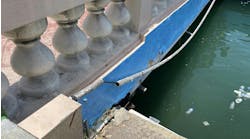How well do you know the Code? Think you can spot violations the original installer either ignored or couldn't identify? Here's your chance to moonlight as an electrical inspector and second-guess someone else's work from the safety of your living room or office. Joe Tedesco, who has a knack for finding shoddy electrical work, did the dirty work and found this mess. Now it's your turn to identify the violation.
Find the Answer
Answer:
This installation offered too many violations to list, but these three winners listed the most relevant of the bunch.
Jerry Parnell, P.E., engineer III, City Water, Light & Power, Springfield, Ill., submitted this response: “Flexible cords and cables shall be protected from accidental damage,” he wrote. “Sharp corners and projections shall be avoided. Where passing through doorways or other pinch points, protection shall be provided to avoid damage.” This wording comes from 590.4(H) of the 2005 NEC. Parnell went on to point out that the pictured manhole would be considered a sharp corner and that cable assemblies and flexible cords and cables must be supported in place at intervals that ensure that they'll be protected from physical damage, per 590.4(J).
Mike Doberdruk, P.E., president, Crown Consulting Engineers, Willoughby Hills, Ohio, noted “Cables passing through doorways are subjected to abuse, are bent over each other, contain splices, and are unsupported!”
Raymond Keith, sales manager, Electric Motor Shop and Supply, Fresno, Calif., also correctly identified a violation of the requirements of Art. 590. He added, “I would not like to be the one who walks in this area if one of the cords failed.”
Violations of Art. 305 in the 1999 NEC, Art. 527 in the 2002 NEC, and Art. 400 of the 2005 NEC are also evident.



